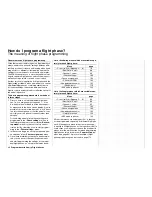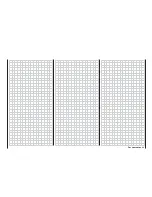
86
Program description:
Transmitter controls
Dual Rate / Expo
Adjustment of control characteristics for aileron, elevator and rudder
Aileron
100%
Elevator
Rudder
DUAL
EXPO
SEL
SEL
100%
0%
0%
0%
100%
The
Dual Rate function
provides a means of swit-
ching to reduced control travels for aileron, elevator
and rudder (control functions 2 … 4) in fl ight via an
external switch; the D/R values can be set separate-
ly for each fl ight phase. A separate menu (»
Channel
1 curve
«) is provided for setting up a curve for control
function 1 (throttle / brake). This curve can feature up
to eight separately programmable points, and is set
up in the “Channel 1 curve” menu.
The control travels for each switch position can be set
to any value within the range 0 to 125%, separate-
ly for each direction. Dual Rate works in a similar way
to transmitter control travel adjustment in the »
Trans-
mitter control adjust
« menu, but the Dual Rate func-
tion does not affect the servo directly; instead it af-
fects the corresponding
control function
, regardless of
whether that function controls a single servo or mul-
tiple servos via any number of complex mixer and
coupling functions.
The
exponential control characteristic
works in a diffe-
rent way: if values greater than 0% are set, exponen-
tial provides fi ne control of the model around the cen-
tre position of the primary control functions (aileron,
elevator and rudder), without forfeiting full movement
at the end-points of stick travel. If you set values lower
than 0%, travel is increased around the neutral posi-
tion, and diminishes towards the extremes of travel.
The degree of “progression” can be selected within
the range -100% to +100%; 0% equates to normal
(i. e. linear) control characteristics.
A further application for exponential is to improve the
linearity of rotary-output servos, which are the stan-
dard nowadays. The movement of the control surface
is inevitably non-linear with a rotary servo, as the li-
near movement of the output disc or lever diminishes
progressively as the angular movement increases,
i. e. the rate of travel of the control surface diminishes
steadily towards the extremes, dependent upon the
position of the linkage point on the output disc or le-
ver. You can compensate for this effect by setting an
Expo value greater than 0%, with the result that the
angular travel of the output device increases dispro-
portionately as stick travel increases.
Like Dual Rates, the Expo setting applies directly
to the corresponding control function, regardless of
whether that function controls a single servo or mul-
tiple servos via any number of complex mixer and
coupling functions. Like the Dual Rate function, Expo
can also be switched on and off in fl ight if a switch is
assigned to it, and can also be programmed separa-
tely for different fl ight phases.
Since switches can be assigned to the Dual Rate and
Expo functions with complete freedom, it is also pos-
sible to operate several functions using one and the
same switch. The result of this is that Dual Rates and
Expo can be controlled simultaneously using a sing-
le switch, and this can be advantageous – especially
with very high-speed models.
The graphic screen displays the curve characteristics
directly. When you select the appropriate menu line,
the central vertical line follows the movement of the
stick concerned, so that you can easily observe how
the curve value changes relative to the defl ection of
the transmitter control.
Different Dual Rate and Expo settings in fl ight
phases
If you have set up different fl ight phases in the »
Pha-
se settings
« and »
Phase assignment
« menus, the
assigned fl ight phase name – e. g. “normal” – is dis-
played at bottom left of the screen. Operate the ap-
propriate switch to move between fl ight phases.
Dual Rate function
If you wish to switch between two possible D/R set-
tings, select the
fi eld and assign a switch, one
of the control switches (by moving the corresponding
transmitter control), or - if necessary - even one of the
logical switches L1 … L8 or L1i … L8i as described in
the section “Assigning control switches” …
100%
DUAL
EXPO
SEL
SEL
100%
0%
0%
0%
100%
«Normal »
Aileron
Elevator
Rudder
Move desired switch
to ON position
(ext. switch: ENTER)
… on page 32. If you use one of the “G” switches, the
position of the stick or other transmitter control serves
as the switch.
In this case it is essential to move to the »
Control
switches
« menu (see page 94) or the »
Logical swit-
ches
« menu (see page 97) and assign the control
switch or logical switch to the transmitter control you
wish to use. Whichever switch you assign, it will ap-
pear in the screen display together with a switch sym-
bol which indicates the direction of operation when
you move the switch.
Select the left-hand
SEL
fi eld to change the Dual
Rate value, and use the rotary control in the highligh-
ted fi eld to set the values for each of the two switch
positions separately, e. g. in the “normal” fl ight phase:
DUAL
EXPO
SEL
SEL
100%
0%
0%
0%
100%
«Normal »
2
125%
Aileron
Elevator
Rudder
The Dual Rate curve is shown simultaneously in the
Summary of Contents for mx-24s
Page 1: ...1...
Page 19: ...19 For your notes...
Page 35: ...35 For your notes...
Page 41: ...41 41 For your notes...
Page 57: ...57 For your notes...
Page 63: ...63 63 For your notes...
Page 69: ...69 69 For your notes...
Page 85: ...85 85 For your notes...
Page 99: ...99 For your notes...
Page 143: ...143 For your notes...
Page 191: ...191 For your notes...
Page 212: ...212 212 For your notes...
Page 213: ...213 213 For your notes...
Page 214: ...214 For your notes...
Page 216: ...216...
















































